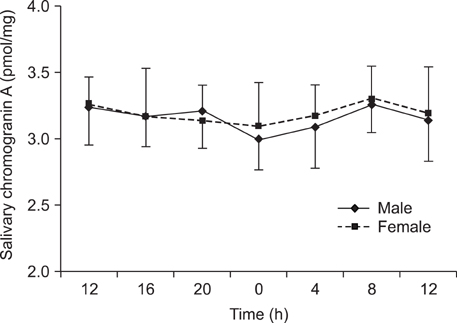J Vet Sci.
2008 Dec;9(4):421-423. 10.4142/jvs.2008.9.4.421.
Circadian variations in salivary chromogranin a concentrations during a 24-hour period in dogs
- Affiliations
-
- 1Department of Small Animal Internal Medicine, School of Veterinary Medicine, Kitasato, University, Towada, Aomori 034-8628, Japan. higuchi@vmas.kitasato-u.ac.jp
- KMID: 1104919
- DOI: http://doi.org/10.4142/jvs.2008.9.4.421
Abstract
- The purpose of this study was to determine if salivary chromogranin a secretion in dogs exhibits a circadian rhythm. Saliva sampling was performed during three different sessions occurring in three nonconsecutive 24-h periods. Sixteen healthy adult beagle dogs (8 males and 8 females) were moved to a sampling room and housed individually in cages. Saliva samples were obtained every 4 h from 12:00 p.m. to 12:00 p.m. the following day. In the interest of habituation, saliva was obtained hourly from each dog 3 h before the experiment was started. Salivary chromogranin A concentrations were measured using an enzyme-linked immunosorbent assay. No circadian rhythm was detected for salivary chromogranin A secretion, and no differences in salivary chromogranin A concentrations measured every 4 h were demonstrated during the 24-h cycle in dogs.
Keyword
MeSH Terms
Figure
Reference
-
1. Akiyoshi H, Aoki M, Shimada T, Noda K, Kumagai D, Saleh N, Sugii S, Ohashi F. Measurement of plasma Chromogranin A concentrations for assessment of stress responses in dogs with insulin-induced hypoglycemia. Am J Vet Res. 2005. 66:1830–1835.
Article2. Banks P, Helle K. The release of protein from the stimulated adrenal medulla. Biochem J. 1965. 97:40C–41C.
Article3. Blaschko H, Comline RS, Schneider FH, Silver M, Smith AD. Secretion of a chromaffin granule protein, chromogranin, from the adrenal gland after splanchnic stimulation. Nature. 1967. 215:58–59.
Article4. Den R, Toda M, Nagasawa S, Kitamura K, Morimoto K. Circadian rhythm of human salivary chromogranin A. Biomed Res. 2007. 28:57–60.
Article5. Depalatis L, Moore J, Falvo RE. Plasma concentrations of testosterone and LH in the male dog. J Reprod Fertil. 1978. 52:201–207.
Article6. Gobello C, Bolognani F, de la Sota RL, Goya RG. Twenty-four-hour profiles of serum prolactin and luteinizing hormone in anoestrous crossbred bitches. Reprod Domest Anim. 2001. 36:41–45.
Article7. Gobello C, Corrada YA, Castex GL, de la Sota RL, Goya RG. Secretory patterns of growth hormone in dogs: circannual, circadian, and ultradian rhythms. Can J Vet Res. 2002. 66:108–111.8. Hendy GN, Bevan S, Mattei MG, Mouland AJ. Chromogranin A. Clin Invest Med. 1995. 18:47–65.9. Kanno T, Asada N, Nagasawa S, Yanaihara N. [Ca2+] i-dependent secretory responses (salivary chromogranin A, flow and protein) to α- and β-adrenergic stimulation in isolated and perfused rat submandibular glands. Biomed Res. 2001. 22:33–43.
Article10. Kemppainen RJ, Sartin JL. Evidence for episodic but not circadian activity in plasma concentrations of adrenocorticotrophin, cortisol and thyroxine in dogs. J Endocrinol. 1984. 103:219–226.
Article11. Koyama T, Omata Y, Saito A. Changes in salivary cortisol concentrations during a 24-hour period in dogs. Horm Metab Res. 2003. 35:355–357.
Article12. Nakane H, Asami O, Yamada Y, Harada T, Matsui N, Kanno T, Yanaihara N. Salivary chromogranin A as an index of psychosomatic stress response. Biomed Res. 1998. 19:401–406.
Article13. Saruta J, Tsukinoki K, Sasaguri K, Ishii H, Yasuda M, Osamura YR, Watanabe Y, Sato S. Expression and localization of chromogranin A gene and protein in human submandibular gland. Cells Tissues Organs. 2005. 180:237–244.
Article14. Sato F, Kanno T, Nagasawa S, Yanaihara N, Ishida N, Hasegawa T, Iwanaga T. Immunohistochemical localization of chromogranin A in the acinar cells of equine salivary glands contrasts with rodent glands. Cells Tissues Organs. 2002. 172:29–36.
Article15. Takahashi Y, Ebihara S, Nakamura Y, Takahashi K. A model of human sleep-related growth hormone secretion in dogs: effects of 3, 6, and 12 hours of forced wakefulness on plasma growth hormone, cortisol, and sleep stages. Endocrinology. 1981. 109:262–272.
Article16. Takiyyuddin MA, Neumann HP, Cervenka JH, Kennedy B, Dinh TQ, Ziegler MG, Baron AD, O'Connor DT. Ultradian variations of chromogranin A in humans. Am J Physiol. 1991. 261:R939–R944.
Article17. Thun R, Eggenberger E, Zerobin K. 24-hour profiles of plasma cortisol and testosterone in the male dog: absence of circadian rhythmicity, seasonal influence and hormonal interrelationships. Reprod Domest Anim. 1990. 25:68–77.
Article18. Winkler H, Fischer-Colbrie R. The chromogranins A and B: The first 25 years and future perspectives. Neuroscience. 1992. 49:497–528.
Article
- Full Text Links
- Actions
-
Cited
- CITED
-
- Close
- Share
- Similar articles
-
- Circadian variations of serum thyroxine, free thyroxine and 3,5,3'triiodothyronine concentrations in healthy dogs
- Determination of Appropriate Sampling Time for Job Stress Assessment: the Salivary Chromogranin A and Cortisol in Adult Females
- Circadian and Seasonal Variations in the Frequency of Onset of Acute Myocardial Infarction
- Circadian Rhythm Disruption in Cancer Biology: A Review of Literature
- Neurobiological Functions of the Period Circadian Clock 2 Gene, Per2



